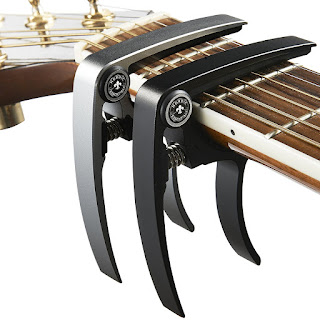When you're first starting out as a guitarist, all you need
is your instrument and a pick to learn notes, chords and a few simple,
no-frills songs. You want your sound to be comparable to that of the players
who inspired you to take up the guitar in the first place.
How to take this to next level?
The answer is
gear, things like amplifiers, picks, and pedals. Gadgets that help you achieve
the different textures and effects you hear in your favorite music. Wading into
all the gear that is available to you can be somewhat intimating and confusing
though. So where do you start when you decide to introduce gear to your
playing?
The following
are essential pieces of gear to help you as you set out to create your own
sound. They are suggested with the beginner in mind.
Picks: A pick might not be the most exciting gear out there (you
might not even consider them gear), but if you think a pick is a pick is a
pick, think again. Picks provide a multitude of different tonal options and
flavors. A simple change of plectrum can completely change your sound. Not
only are picks available in different colors, they also come in various sizes,
shapes and materials, like plastic, stone, wood and even tortoiseshell. In
general, the harder and denser the material, the brighter, more crisp and
cutting the resulting sound. Softer the material the warm and full the
sound.
Amplifier: Buying an
amplifier is one of the most important choices a guitarist will make, because a
great sounding amplifier will make even a bad guitar sound decent, but a great
guitar will sound terrible through a bad amplifier.
Guitar
tuner: Of
course, it's essential that your instrument is in tune, otherwise you'll never
achieve the sound you're after, and not to mention the pain you will inflict on
anyone within earshot. So have a good guitar tuner.
Capo:
Playing
a barre chord is not easy, you should own a capo, no matter what style of music
you play. A capo is a small tool that clamps down on all the strings of your
guitar at once, barring them in a particular fret, which enables you to raise
the pitch of the instrument by creating a new nut. In essence, a capo is like a
floating nut.
Capos make it
a breeze to transpose a song to a higher key on the spot while still playing
basic chords in open positions. This comes in handy if you're singing or
accompanying a vocalist who can't sing a song in the key it's written. Instead
of having to relearn the chords of the song in another key, some of which might
be tricky to play, you simply move the capo on the fret-board until you find a
key that suits you.
Slide:
A
slide is another piece of gear that will energize your playing and give your
work a fresh tone. A slide is a hollow tube that is made from a variety of
materials including bronze, brass, stainless steel, copper, aluminum, glass,
porcelain and ceramic. With slide guitar you play the strings, not the frets,
gliding up and down the fret-board without lifting off the strings, which
creates continuous transitions in pitch.
Pedals: Once you have
developed your guitar skills, you may want to introduce a pedal. Pedal,
sometimes called guitar pedals or stompboxes, are small electronic units that
change your guitar's sound in a specific way. Pedals are used to produce
special effects such as wah-wah, delay, tremolo, chorus, flanger, distortion,
and fuzz. They can be as simple as one effect that adds layers to your sound,
or as complex as a chain of pedals that are connected between the guitar and
the amplifier, adjusting your sound in a variety of ways.
A Distortion Pedal does just that—distorts the sound coming through the
amp. It's a sound most commonly heard in heavy metal and harder rock, as it is
typically a harsher effect.
A Delay Pedal creates an echo of the sound that's just been
played. The effect that this pedal creates is reminiscent of yelling in a
large, vacant space. The sound bounces repeatedly off the surfaces, becoming
softer as it repeats.
While the
delay pedal provides a distinct echoing sound, the Reverb Pedal creates
a fuller sound by allowing the notes to reverberate after they've been played.
Reverb is one of the most fundamental effects for electric guitar, which is why
it is already built into most amps. Reverb adds depth to your sound.
Using pedals
takes practice and experimentation so, as someone new to gear, you should play
around with one effect at a time, learning each thoroughly, before moving on to
more complex setups.









Good information.
ReplyDelete